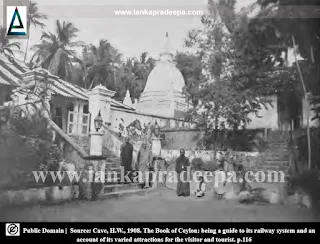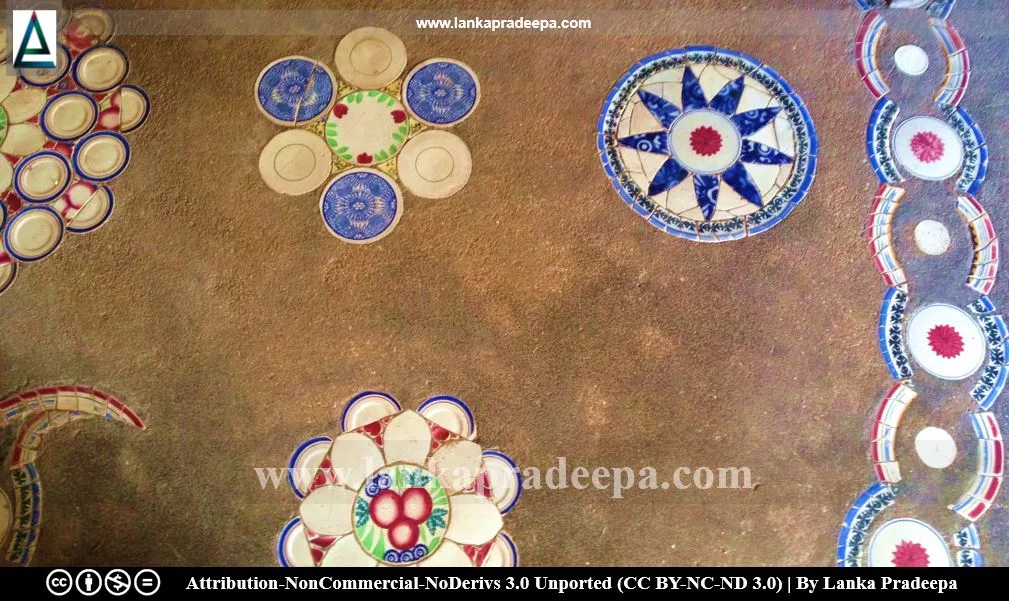
|
Sri Subodharama Raja Maha Viharaya |
Sri Subodharama Raja Maha Viharaya, also known as Karagampitiya Viharaya (Sinhala: කරගම්පිටිය ශ්රී සුබෝධාරාම රජ මහා විහාරය), is a historic Buddhist temple situated in Dehiwala in Colombo District, Sri Lanka (Hettige & Sudasinghe, 2015; Wickramasinghe, 2015). Located about 10 km distance from Colombo, the temple can be reached by travelling along the Colombo - Galle main road and turning to the Subodarama Viharaya road which is located at a distance of 250 m from the Dehiwala junction.
History

Karagampitiya Subodharamaya has a history extending from the reign of King Parakramabahu VI of Kotte [(1412-1467 A.D.) Embuldeniya, 2014]. During this reign, a village called Medimala (Nedimale) had been offered to the Natha Devalaya at Pepiliyana (Chutiwongs et al., 1990). At the time, the western part of this village was occupied by the fishing community and hence that part was known as Karagampitiya. To banish enemies and protect the fishermen in the village, the king had erected a Devalaya at the foot of a Na-tree located on a hillock of Karagampitiya (Chutiwongs et al., 1990). However, this Devalaya is said to have been destroyed by the Portuguese and its stone pillars were brought by them to construct the Saint Anthony's Church at Mount Lavinia (Chutiwongs et al., 1990).
During the Dutch Period, a Dutch church and an Ambalama were built at Karagampitiya. It is said that the first incumbent of Karagampitiya Viharaya, Hikkaduwe Indrajothi Thera was living in that Ambalama (Chutiwongs et al., 1990). In 1881, during the British period, when the Methodist Church of Mount Lavinia was built, the stone pillars which had been brought to the Dutch church were again returned to the temple at Karagampitiya (Chutiwongs et al., 1990).

Paintings

The Mural paintings of the main shrine room of Karagampitiya Viharaya belong to the 19th century and are categorized under the Southern school art style (Wijerathna et al., 2011). Of them, the earliest are found in the inner walls of the ambulatory spaces (Thenuwara, 2006). The paintings found in the image house as well as in the preaching hall are considered important as they contain visual evidence to understand the 19th-century textile designs in the country (Karunaratne & Bhagya, 2018; Wickramasinghe, 2015).
Queen Victoria painting
Indicating the coronation as the queen of all colonial countries, a portrait of Queen Victoria has been painted over the inner entrance door of the image house of Karagampitiya temple (Chutiwongs et al., 1990). A similar portrait of her also can be seen in the image house of Kotte Raja Maha Viharaya (Chutiwongs et al., 1990).
Mosaic Arts
Mosaic art created by fragments of porcelain products and coins can be seen in the image house and in the Sath-Sathi-Mandiraya (Embuldeniya, 2019). In the image house, the mosaics are at the sanctum and the outer chamber (in front of the two entrances of the sanctum). Among the mosaic, the figures of animals (tusker, horse, lion, leopard, rabbit, etc.), florals (coconut tree, banana tree, lotus flowers, etc.), auspicious objects (flags, Sesath, Chamara, etc.), and other (such as a clock) are found (Embuldeniya, 2019).
Besides the image house, mosaic art could be seen in the inner chamber, verandah, and entrance pandol of Sath-Sathi-Mandiraya (Embuldeniya, 2019).
A Protected Site
The image house, Sathsathi Mandiraya, Bana preaching hall, Awasage and relic chamber belonging to Karagampitiya Subodharama Purana Vihara premises in the Karagampitiya Grama Niladhari Division in Dehiwala Divisional Secretariat Division are archaeological protected monuments, declared by a government Gazette notification published on 23 February 2007.




Related Posts
Read Also
References
Books, Government Gazette Notifications, Journal Articles
1) Chutiwongs, N.; Prematilaka, L.; Silva, R., 1990. Sri Lanka Bithu Sithuwam: Karagampitiya (Paintings of Sri Lanka: Karagampitiya). Sri Lanka Archaeological Authority: Centenary publication. Central Cultural Fund. pp.33-40.
2) Embuldeniya, P., 2014. Countries which imported porcelain Products to Sri Lanka during 19th century: with special reference to mosaic art. Book of Abstracts, Annual Research Symposium, Faculty of Graduate Studies, University of Kelaniya, Sri Lanka. p.52.
3) Embuldeniya, P., 2019. Mosaics at Karagampitiya Subodharama Vihara, Sri Lanka. EPRA International Journal of Multidisciplinary Research. Vol: 5, Issue: 3. pp.19-27.
4) Hettige, U. and Sudasinghe, A.U., 2015. Dancing costumes on the timber paintings in the Karagampitiya temple sermon hall (Dharma mandapaya). p.13.
5) Karunaratne, P.V.M. and Bhagya, N., 2018. A study of an iconic representations of textile designs in temple paintings of Sri Lanka. World Scientific News, 103, pp.19-31.
6) The Gazette of the Democratic Socialist Republic of Sri Lanka. No: 1486. 23 February 2007. p.123.
7) Thenuwara, C., 2006. The Murals of
the Karagampitiya Subodharama Temple: An Investigation of the Pictorial Language of these murals of the Southern Province of Sri Lanka (Doctoral dissertation). p.IV.
8) Wickramasinghe, A.T.P., 2015. An Analysis of 19th century female clothing in Sri Lanka: depicted from Kathaluwa and Karagampitiya temple paintings.
9) Wijerathna, D.S., Ariadurai, S.A. and De Silva, N., 2011. Study on pictorial expression of the mural paintings at Subodharamaya temple murals of Karagampitiya, Dehiwala. pp.145-148.
10) Wijesuriya, B., 2022. Kolamba urumaya narambamu (In Sinhala). Central Cultural Fund. ISBN: 978-955-613-306-6. pp.11-12.
Location Map
Dynamic Google Map
Attribution
To Whom
1) Subodharama Vihara 4 by L Manju is licensed under CC BY SA 4.0.

